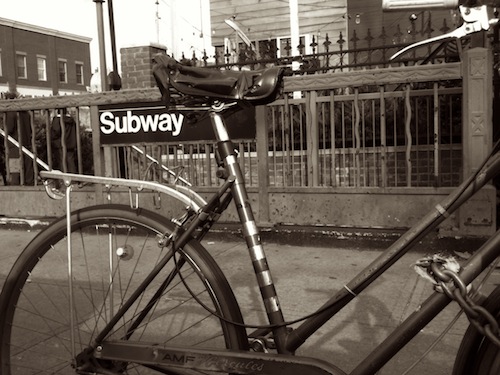
Let me state, emphatically, that I am a supporter of urban cycling. I grew up in Manhattan, and the bike was not only how I commuted to and from school, but how I came to learn about the city, to explore the remote areas and industrial spaces that still are a fascination to me. With a bike, I found, you could travel not just in space, but in time, back to parts of the city that seemed frozen in history. As an adult, I have been an occassional bicycle commuter. Which is all to say, I applaud the extraordinary expansion of biking infrastructure undertaken by the NYC DOT, under the leadership of Janette Sadik-Kahn.
Progressive members of the design community love cycling, and I think not just because it is a healthful and environmentally sustainable mode of transportation. Designers, I suspect, are attracted to bikes because designers love making objects—it is what they are trained to do—and the bike is an object that is simple enough that anyone can tailor it to their own specifications. It promotes engagement with itself. You can build your own. You can modify your own. And then you can go out and campaign for more biking infrastructure in your neighborhood. There's a class aspect at work in this interest in cycling, as well: commuting by bicycle is a lot more attractive if you can live close to your workplace, and this often means expensive real-estate that designers can afford.
I wish designers cared as much about mass transit as they did about their bikes. We don't get very many articles in the design press about our decayed subway system, nor does there seem to be much of a galvanized movement within the design community to do anything about it. (I'm speaking here primarily about New York City.) Transportation Alternatives, a wonderful organization, bills itself as an "advocate for bicycling, walking and public transit," which seems bizarrely out of order to me. When the design (and architecture) press covers mass transit here, it's often to wax nostalgic about Massimo Vignelli's map of the system—wonderful, I admit.
New York is never going to be Amsterdam. Commuting by bicycle may work for some people, and the more the better, but for the overwhelming majority it's not going to be a viable option most of the time. New York is a city of public transit, and that's where the vast majority of our attention should be directed. It is the single most important urban design issue facing the city and its residents. By far. More than 5.1 million rides are taken on the subway on an average weekday. Bus service adds another 2.2 million. Service cutbacks loom. Last week I renewed a Metrocard for a month. The fee was $104. The fee for renewing my driver's license for ten years? $80. Our priorities need to change.
The problem, of course, is that fixing the subway system is not like adding a bike lane here or there. The MTA is an onerous authority with little accountability and not much accessibility. How do you interact with that behemoth? The answer is political engagement. But first we have to care.
